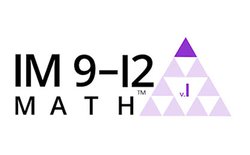IM 9–12 Math™ certified by Illustrative Mathematics is a problem-based core curriculum designed to address content and practice standards to foster learning for all. The teacher-tested, research-based curriculum is built around focus, coherence, and rigor. Students learn by doing math, solving problems in mathematical and real-world contexts, and constructing arguments using precise language. Teachers facilitate student learning with high-leverage routines to guide learners to understand and make connections.
IM 9–12 Math is part of IM K–12 Math, which also includes IM 6–8 Math and IM K–5 Math. It is fully aligned to college and career-ready standards to prepare students for success with mathematics.
IM 9–12 Math certified by Illustrative Mathematics is delivered exclusively by IM Certified Partners who offer a range of options, including a freely available option as well as enhanced digital platforms and print formats to meet the diverse needs of districts. The IM Certified designation guarantees the curriculum is authored, reviewed, and updated by IM, and has the rigor, structure, and coherence as developed by the IM authors.
Formats/platforms used:
IM 9–12 Math is offered via a freely available open educational resource (OER) option, as well as through for-fee print and digital platforms from IM Certified Partners.
Primary website’s URL:

Problem solved:
In many U.S. schools, students are expected to learn math by watching and copying what the teacher does. Mathematics, however, is not a spectator sport — and this approach does not make math stick. Educators want to provide mathematical experiences that help students succeed in school and beyond. Yet, it is challenging to find resources and support for giving their students an enduring understanding of mathematics.
Illustrative Mathematics (IM) is a nonprofit organization dedicated to creating a world where all learners know, use, and enjoy mathematics. IM provides access to high-quality instructional materials, professional learning, and a community to help teachers make meaningful shifts in their mathematics instruction and support the growth of all students. With an uplifting, engaging, and inclusive approach, IM helps students develop skills, understandings, and practices that will stay with them for a lifetime.
Designed for high school learners, IM 9–12 Math encourages the problem-solving skills students need to better understand the real world. The standards-aligned, research-based curriculum tells a story about Algebra 1, Geometry, and Algebra 2. The story of each course is told in units; each unit has a narrative that describes the mathematical work that will unfold in that unit. Each lesson in the unit also has a narrative.
IM 9–12 Math meets all expectations across all three EdReports Gateways for Focus and Coherence, Rigor and Mathematical Practices, and Usability. EdReports (edreports.org) is an independent nonprofit that reviews K–12 instructional materials. The full reports can be found at: https://www.edreports.org/reports/overview/learnzillion-illustrative-mathematics-traditional-2019
and https://www.edreports.org/reports/overview/kendall-hunts-illustrative-mathematics-traditional-2019.

Grades/age ranges:
Grades 9–12
Does the product address core/supplemental/special needs/extracurricular/professional development?
IM 9–12 Math is a core mathematics curriculum. It can be used in heterogeneous classrooms. Careful attention is paid to giving every student access to the mathematics by not assuming familiarity with contexts, and giving teachers tools to recognize unfinished learning. Built-in supports are included for teachers of students with disabilities and students with emerging English language proficiency. Extension activities are offered for any student who is ready to go deeper into grade-level content.
IM Professional Learning certified by Illustrative Mathematics is deeply integrated with the IM 9–12 Math curriculum. The professional learning was developed and is continuously refined by the curriculum’s authors, who work hand-in-hand with IM Certified Facilitators to create high-quality learning experiences for mathematics educators. The program provides teachers and leaders with long-term, sustainable support for developing, refining, and reflecting on instructional practices.
Standards:
IM 9–12 Math is aligned to the high school Common Core State Standards in Mathematics. When content below grade level is included as an on-ramp to new content, this is indicated so teachers can make an informed choice about the extent to which they will use it in their classes. For students who are ready to go deeper into the content, extension activities are offered as an alternative to offering work above grade level.
Lesson time needed:
The lessons are designed to be used as full-year, core instructional mathematics course materials with 45-minute daily class meetings. Guidance documents are also provided for adapting the materials to a block schedule.
Pricing models:
For flexibility and accessibility, multiple formats and platforms are available, including a freely available OER option as well as enhanced digital platforms and print formats that are available for a fee.
What makes IM 9-12 Math unique?
IM 9–12 Math materials are designed with the goal that all students are doing mathematics during most of the instructional time. IM chose a problem-based approach for this reason, and designed tasks and instructional routines so all students are actively engaged.
With IM 9–12 Math, students have opportunities to see what they can figure out before having things explained or being told what to do. Tasks in the curriculum are purposefully designed to provide students with these opportunities and teachers with the guidance to facilitate them. The goal is to give students just enough background and tools to solve initial problems successfully, and then set them to increasingly sophisticated problems as their expertise increases. The teacher’s role is to ensure students understand the context and what is being asked, ask questions to advance students’ thinking in productive ways, help students share their work and understand others’ work through orchestrating productive discussions, and synthesize the learning with students at the end of activities and lessons.
IM 9–12 Math instructional units are organized with a flow: invitation to the mathematics, deep study to develop concepts, and consolidating ideas and applying them to new contexts. Ongoing practice and work toward fluency is continuous. Within the instructional units, lessons are laid out with an organization: warm-up, one or more instructional activities, synthesis, cool-down. Even deeper in the lesson, activities hold a routine structure: launch, student work time, synthesis. Every lesson, activity, and component serves a purpose within the unit.
Characteristics:
IM is designed so that high school students can become fluent users of digital tools to solve problems and produce representations to support their own understanding. In most cases, instead of being given a pre-made applet to explore, students have access to a suite of linked applications, such as graphing tools, synthetic and analytic geometry tools, and spreadsheets. Students (and teachers) learn from activities within the curriculum how to use the tools, but are not always told when to use them, and student choice in problem-solving approaches is valued. When appropriate, pre-made applets may be included to allow students to practice many iterations of a skill with error checking, to shorten the amount of time it takes students to create a representation, or to help students see many examples of a relationship in a short amount of time. Activities that incorporate digital tools are included when they are required by the standard being addressed, or when they offer a meaningful alternative to the paper-and-pencil version to achieve the learning goals of the lesson.
To support teacher learning, every decision made about the flow of the mathematics is explicitly described through lesson narratives and activity narratives, including whether the decision is required by the standards or a choice made by the authors. Whenever there is a connection to the mathematical work of a prior or future lesson, unit, or grade, it is pointed out. The mathematical purpose of every lesson and activity is made clear. The teacher-facing portions of lesson plans are intended to help teachers better understand the mathematics they are teaching and the instructional moves designed to help their students learn.
Here's what users are saying:
“The curriculum does a fantastic job of spiraling previous content into current units, which means I do not have to find other ways to incorporate the ideas — IM does it for me! This curriculum allows students to dig deep into math in a fun and practical way, and I get to be a guide that cheers them on!”
— Caitlin Craft, Math Teacher, Albuquerque Public Schools, New Mexico
“IM 9–12 Math has spurred a rapid paradigm shift in how I go about teaching and learning mathematics. Furthermore, my students have developed a deeper understanding of mathematical concepts through making meaning of their conversations with each other and myself about the topic at hand.”
— Joseph Dziuba, Math Teacher, New Brunswick Public Schools, New Jersey
“I have used the IM Algebra I curriculum this year. It has been such a rewarding and amazing experience for my students. I feel like they have progressed so much more in their mathematical understanding. The quality of my instruction and the quality of intervention in my immersion class have improved so much, and it is entirely due to the thoughtfulness and the quality of your curriculum.”
— Jim Dougherty, Mathematics Teacher, Cincinnati, Ohio











